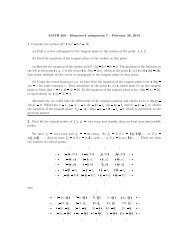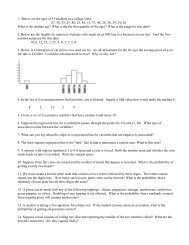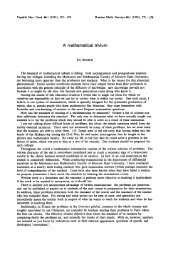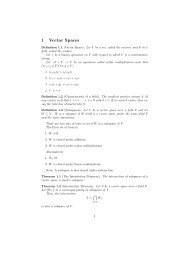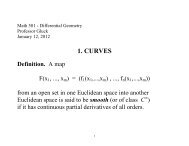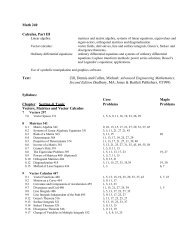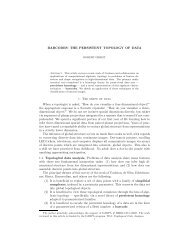MORSE THEORY AND THE GAUSS-BONNET FORMULA Alina ...
MORSE THEORY AND THE GAUSS-BONNET FORMULA Alina ...
MORSE THEORY AND THE GAUSS-BONNET FORMULA Alina ...
Create successful ePaper yourself
Turn your PDF publications into a flip-book with our unique Google optimized e-Paper software.
index(p) = 2, index(q) = index(r) = index(a) = 1, index(s) = 0, and we obtain<br />
χ(M) = (−1) 0 · 1 + (−1) 1 · 3 + (−1) 2 · 1 = −1 as expected.<br />
Example. Consider the annulus M ⊂ R 2 and the height function h representing<br />
the y-coordinate. There are four critical points, all on the boundary, but only two of<br />
them are used for computing χ(M) = (−1) 0 · 1 + (−1) 2 · 1 = 0.<br />
3.2 Isometric immersions and the Gauss map<br />
Let M n be a submanifold of R N . The unit normal bundle of M is a bundle with fiber<br />
S N−n−1 and total space of dimension N − 1 defined as:<br />
ν 1 M = {(x, u) : x ∈ M, u ∈ TxR N , u ⊥ TxM and �u� = 1}<br />
For any (x, u) ∈ ν 1 M, the tangent space T(x,u)ν 1 M splits into a horizontal subspace<br />
and a vertical subspace: T(x,u)ν 1 M = Hor T(x,u)ν 1 M ⊕Vert T(x,u)ν 1 M. In the canonical<br />
metric on ν 1 M the horizontal and vertical subspaces are orthogonal to each other.<br />
This splitting gives a canonical volume form dV ν 1 M on ν 1 M which locally coincides<br />
with dVM ∧ dV S N−n−1.<br />
10



